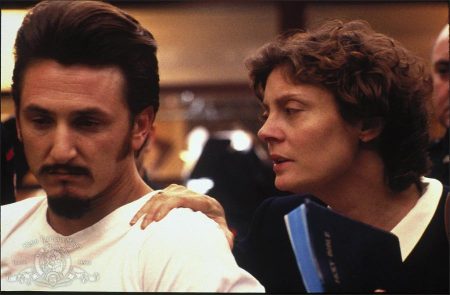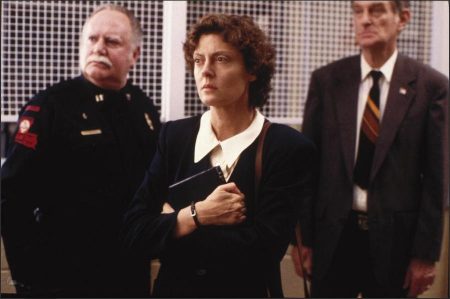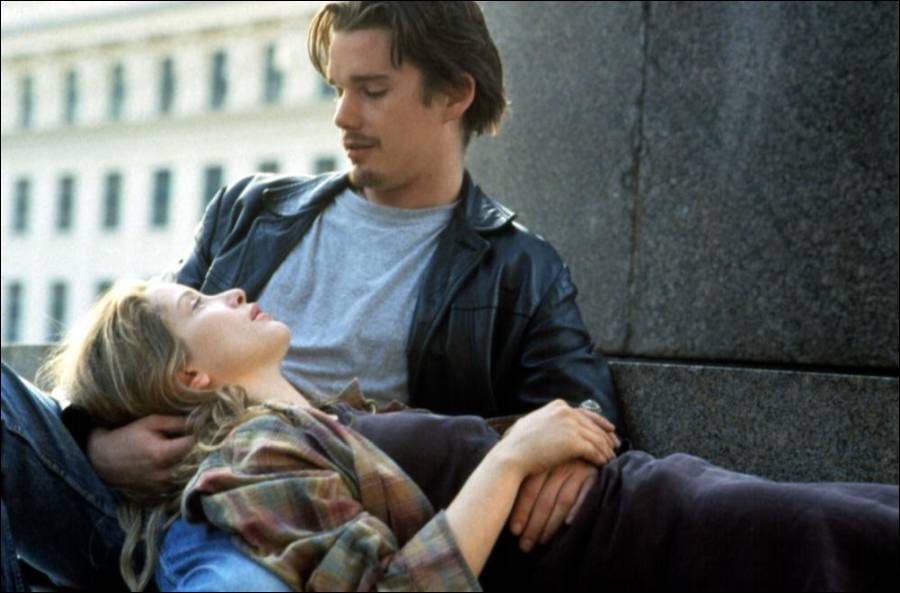Dead Man Walking movie storyline. A convicted murderer on Death Row and the nun who befriends him. Through the portrayal of finely drawn characters and their interactions as the days, hours, and minutes tick down to the condemned man’s execution, powerful emotions are unleashed.
While Matthew Poncelet and Sister Prejean desperately try to gain a stay of execution from the governor or the courts, scenes are intercut from the brutal crime, gradually revealing the truth about the events that transpired. In addition to her temporal help, the nun also tries to reach out spiritually and assist as a guide to salvation.
Dead Man Walking is a 1995 American crime drama film starring Susan Sarandon and Sean Penn, and co-produced and directed by Tim Robbins, who adapted the screenplay from the non-fiction book of the same name. Sister Helen Prejean (Sarandon) establishes a special relationship with Matthew Poncelet (Penn), a prisoner on death row in Louisiana, acting as his spiritual adviser after carrying on correspondence with him.
Film Revieaw for Dead Man Walking
“Dead Man Walking,” the emotionally wrenching new movie from writer-director Tim Robbins, begins innocently enough when Sister Helen decides to come to the spiritual aid of a convict awaiting execution in New Orleans’s Angola Prison. A devout nun dedicated to helping the poor in the St. Thomas housing project, the sister, played with moving vulnerability by Susan Sarandon, has only one motive: to assist those in spiritual peril. And Matthew Poncelet (Sean Penn), a trashy punk who has been found guilty of brutally murdering a teenage couple, certainly qualifies. But in opening the door between her world and Poncelet’s, this genuinely good woman can’t possibly know what she’s getting herself into.
What this intelligent, balanced, devastating movie puts before us is nothing less than a contest between good and evil. With his satanic goatee and vainglorious pompadour, Poncelet carries the shadow of death within him. He’s a viper, manipulative, lethal, capable of anything—anything, that is, except normal human emotion. To most people—and especially to the parents of the murdered couple—Poncelet is less than an animal, a monster. Who else—what else—could be capable of such horror? And how could such a creature be worthy of the sister’s mercy?
But to Sister Helen, her responsibilities are clear. Regardless of his crimes, Poncelet is one of God’s children, a dark soul seeking salvation. During their first prison encounter, she seems at best naive, and at worst a dupe. Profoundly ill-equipped to deal with the prisoner’s elaborate mind games, she allows herself to be suckered into believing that there might be something in Poncelet’s claims of an unfair trial.
Convinced that Poncelet’s poverty, as much as his crime, put him on death row, Sister Helen tries to get him a new trial. While the legal details are being worked out, she and her spiritual charge stage a series of extraordinary encounters. In her effort to understand him, she asks about his life before prison, but in the process she reveals as much about her circumstances and expectations as he does about his. As a result, a remarkably intimate bond—even a kind of love—develops, despite the wire screen separating them.
For the audience, the rapport between these imposing actors is palpable. Penn’s performance is the fussier of the two, and early on, his surface mannerisms make it difficult for us to get inside the character. Poncelet appears as soulless and irredeemable as everyone thinks he is.
Later, though, we begin to understand that this impenetrable facade is a part of the character’s—not the actor’s—armor. As the legal alternatives are exhausted and the time of execution approaches, Penn allows these protective layers to fall away, one at a time, giving us a glimpse of the man within. The strength of Penn’s work lies in his complete refusal to ask his audience for sympathy. It’s a tough-minded, exacting performance, and equal to anything this gifted actor has ever done.
Sarandon is his match in every sense. During the course of the film, Poncelet is transformed from a monster into a man. But while the sister’s journey may be shorter in moral terms, it is no less harrowing, and Sarandon shows the price she pays for every step. Virtue may be the most difficult thing for an actor to play, but while Sister Helen remains a steadfastly “good” woman, Sarandon never allows any plaster saintliness to creep into her performance.
Dealing with an issue as volatile and complex as the death penalty is a tricky proposition, and in the hands of another filmmaker, “Dead Man Walking,” which is based on the 1993 bestseller by Sister Helen Prejean, might easily degenerate into a simple-minded polemic. But Robbins—whose work here surpasses even the high expectations that followed his debut with “Bob Roberts”—smartly avoids all of them by taking a human, rather than a political, approach to his subject. It’s not an issue movie.
The real subject here is compassion, not capital punishment. “Dead Man Walking” asks whether a man like Poncelet, who has been found guilty of causing inhuman suffering and who appears without either remorse or conscience—who appears to lack even the minimal requisites of a human being—deserves to be treated like one. The movie’s answer is yes, but this conclusion—which flows from the nun’s own attitude—has far less to do with Poncelet than with us.
Dead Man Walking (1995)
Directed by: Tim Robbins
Starring: Susan Sarandon, Sean Penn, Robert Prosky, Scott Wilson, Raymond J. Barry, R. Lee Ermey, Roberta Maxwell, Margo Martindale, Steve Boles, Nesbitt Blaisdell
Screenplay by: Tim Robbins
Production Design by: Richard Hoover
Cinematography by: Roger Deakins
Film Editing by: Lisa Zeno Churgin, Ray Hubley
Costume Design by: Renee Ehrlich Kalfus
Art Direction by: Tom Warren
Music by: David Robbins
MPAA Rating: R for a depiction of a rape and murder.
Distributed by: Gramercy Pictures
Release Date: December 29, 1995
Views: 197






